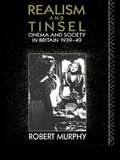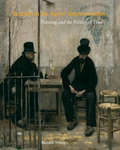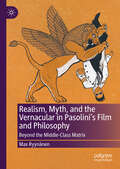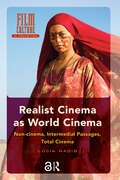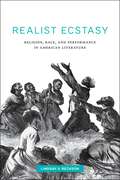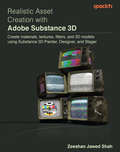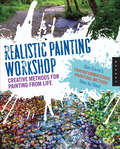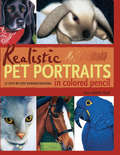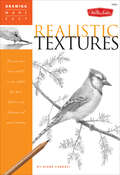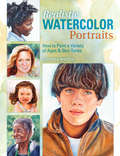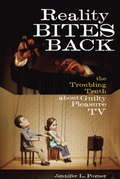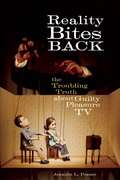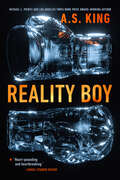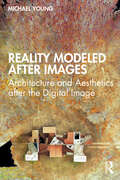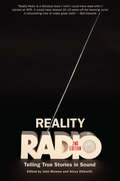- Table View
- List View
Realism and Tinsel: Cinema and Society in Britain 1939-48 (Cinema and Society)
by Robert MurphyFirst published in 1992. Routledge is an imprint of Taylor & Francis, an informa company.
Realism in the Age of Impressionism
by Marnin YoungThe late 1870s and early 1880s were watershed years in the history of French painting. As outgoing economic and social structures were being replaced by a capitalist, measured time, Impressionist artists sought to create works that could be perceived in an instant, capturing the sensations of rapidly transforming modern life. Yet a generation of artists pushed back against these changes, spearheading a short-lived revival of the Realist practices that had dominated at mid-century and advocating slowness in practice, subject matter, and beholding. In this illuminating book, Marnin Young looks closely at five works by Jules Bastien-Lepage, Gustave Caillebotte, Alfred-Philippe Roll, Jean-François Raffaëlli, and James Ensor, artists who shared a concern with painting and temporality that is all but forgotten today, having been eclipsed by the ideals of Impressionism. Young's highly original study situates later Realism for the first time within the larger social, political, and economic framework and argues for its centrality in understanding the development of modern art.
Realism, Myth, and the Vernacular in Pasolini's Film and Philosophy: Beyond the Middle-Class Matrix
by Max RyynänenPier Paolo Pasolini’s lifework has been studied through the lens of queer studies, film studies, poetry, and many other angles, but there are themes that one could still study. This book aims to bring forth a new understanding of Pasolini as someone who worked in various arts, and through appropriating one art with. Max Ryynänen shows Pasolini’s importance for not just film and film theory, but more broadly visual studies, art research and even cultural philosophy – where Pasolini can be seen to be a real pioneer in discussing unprivileged margins in the society. Ryynänen reads Pasolini not just as a semiotician of film, but also as a cultural philosopher, and argues for that interpretation.
Realist Cinema as World Cinema: Non-cinema, Intermedial Passages, Total Cinema (Film Culture in Transition)
by Lúcia NagibThis book presents the bold and original proposal to replace the general appellation of ‘world cinema’ with the more substantive concept of ‘realist cinema’. Veering away from the usual focus on modes of reception and spectatorship, it locates instead cinematic realism in the way films are made. The volume is structured across three innovative categories of realist modes of production: ‘noncinema’, or a cinema that aspires to be life itself; ‘intermedial passages’, or films that incorporate other artforms as a channel to historical and political reality; and ‘total cinema’, or films moved by a totalising impulse, be it towards the total artwork, total history or universalising landscapes. Though mostly devoted to recent productions, each part starts with the analysis of foundational classics, which have paved the way for future realist endeavours, proving that realism is timeless and inherent in cinema from its origin.
Realist Ecstasy: Religion, Race, and Performance in American Literature (Performance and American Cultures #2)
by Lindsay V. RecksonHonorable Mention, Barnard Hewitt Award from the American Society for Theater ResearchExplores the intersection and history of American literary realism and the performance of spiritual and racial embodiment. Recovering a series of ecstatic performances in late nineteenth- and early twentieth-century American realism, Realist Ecstasy travels from camp meetings to Native American ghost dances to storefront church revivals to explore realism’s relationship to spiritual experience. In her approach to realism as both an unruly archive of performance and a wide-ranging repertoire of media practices—including literature, photography, audio recording, and early film—Lindsay V. Reckson argues that the real was repetitively enacted and reenacted through bodily practice. Realist Ecstasy demonstrates how the realist imagining of possessed bodies helped construct and naturalize racial difference, while excavating the complex, shifting, and dynamic possibilities embedded in ecstatic performance: its production of new and immanent forms of being beside. Across her readings of Stephen Crane, James Weldon Johnson, and Nella Larsen, among others, Reckson triangulates secularism, realism, and racial formation in the post-Reconstruction moment. Realist Ecstasy shows how post-Reconstruction realist texts mobilized gestures—especially the gestures associated with religious ecstasy—to racialize secularism itself. Reckson offers us a distinctly new vision of American realism as a performative practice, a sustained account of how performance lives in and through literary archives, and a rich sense of how closely secularization and racialization were linked in Jim Crow America.
Realistic Architectural Visualization with 3ds Max and mental ray
by Jamie Cardoso Roger CussonRevitalize your architectural visualizations by bringing new levels of realism to them with an enhanced command of the mental ray toolset in 3ds Max. Full-color step-by-step tutorials give you a firm understanding of the processes and techniques needed to create impressive interior and exterior visualizations. You'll learn how to prepare materials, light a daytime interior scene, use mr Physical Sky, and how to save time during complex renders. The companion website includes all of the tutorial files and sample files from the book.
Realistic Asset Creation with Adobe Substance 3D: Create materials, textures, filters, and 3D models using Substance 3D Painter, Designer, and Stager
by Zeeshan Jawed ShahGain extensive, practical knowledge of 3D design with Adobe Substance 3D and learn to build a comprehensive portfolio of work with this interactive bookKey FeaturesFind out how to use Adobe Substance 3D swiftly and with little prior knowledgeUse a variety of interactive projects to get familiar with the fundamentalsCreate better career prospects for yourself by mastering 3D design with a single comprehensive guideBook DescriptionAdobe Substance 3D is a comprehensive suite complete with everything an artist needs to create stunning 3D digital materials. Getting a grip on the ecosystem of apps can be challenging for beginners, which is where Realistic Asset Creation with Adobe Substance 3D comes in!This practical guide doesn't bombard you with reams of textual information. Instead, you get an interactive, project-based book that'll help you gain sound knowledge of Adobe Substance 3D and set you on the right path toward a career in 3D design. You'll start off with the rudiments of Adobe Substance 3D Painter, which will enable you to acquire the skills needed to work with layers, masks, shelves, textures, and more. Next, you'll move on to Adobe Substance 3D Designer and become well-acquainted with this node-based design tool as you progress through the chapters. The final section is devoted to Adobe Substance 3D Stager, which teaches you to build complex 3D scenes and visualize your edits in real time.By the end of this Adobe book, you'll have gained a solid understanding of Adobe Substance 3D and developed the skills to build a comprehensive portfolio of work, setting you up for a lucrative career in 3D design.What you will learnDiscover Substance 3D Painter, Designer, and Stager through easy projectsAssemble 3D scenes and set up assets, materials, lights, and camerasExplore the innovative 3D assets library and learn how to digitize your 3D assetsTexture your 3D assets with advanced brushes and Smart MaterialsUse and blend a variety of nodes in Adobe Substance 3D DesignerCreate and export materials using Adobe Substance 3D SamplerWho this book is forThis book is for game designers, 3D generalists, and design students. If you're looking to get started in your 3D career or planning to join 3D generation, then you'll find this book useful. The book assumes very little to no 3D design knowledge. A bit of understanding of the history, functionality, and purpose of the Adobe Substance 3D package is presumed but is not mandatory; however, you must know how to work with Adobe Photoshop.
Realistic Asset Creation with Adobe Substance 3D: Create materials, textures, filters, and 3D models using Substance 3D Painter, Designer, and Stager
by Zeeshan Jawed ShahGain extensive, practical knowledge of 3D design with Adobe Substance 3D and learn to build a comprehensive portfolio of work with this illustrated guideKey FeaturesFind out how to use Adobe Substance 3D swiftly and with little prior knowledgeUse a variety of interactive projects to get familiar with the fundamentalsCreate better career prospects for yourself by mastering 3D design with a single comprehensive guideBook DescriptionAdobe Substance 3D is a comprehensive suite complete with everything an artist needs to create stunning 3D digital materials. Getting a grip on the ecosystem of apps can be challenging for beginners, which is where Realistic Asset Creation with Adobe Substance 3D comes in! This practical guide doesn't bombard you with reams of textual information. Instead, you get an interactive, project-based book that’ll help you gain sound knowledge of Adobe Substance 3D and set you on the right path toward a career in 3D design. You’ll start off with the rudiments of Adobe Substance 3D Painter, which will enable you to acquire the skills needed to work with layers, masks, shelves, textures, and more. Next, you’ll move on to Adobe Substance 3D Designer and become well-acquainted with this node-based design tool as you progress through the chapters. The final section is devoted to Adobe Substance 3D Stager, which teaches you to build complex 3D scenes and visualize your edits in real time. By the end of this Adobe book, you’ll have gained a solid understanding of Adobe Substance 3D and developed the skills to build a comprehensive portfolio of work, setting you up for a lucrative career in 3D design.What you will learnDiscover Substance 3D Painter, Designer, and Stager through easy projectsAssemble 3D scenes and set up assets, materials, lights, and camerasExplore the innovative 3D assets library and learn how to digitize your 3D assetsTexture your 3D assets with advanced brushes and Smart MaterialsUse and blend a variety of nodes in Adobe Substance 3D DesignerCreate and export materials using Adobe Substance 3D SamplerWho this book is forThis book is for game designers, 3D generalists, and design students. If you're looking to get started in your 3D career or planning to join 3D generation, then you'll find this book useful. The book assumes very little to no 3D design knowledge. A bit of understanding of the history, functionality, and purpose of the Adobe Substance 3D package is presumed but is not mandatory; however, you must know how to work with Adobe Photoshop.
Realistic Painting Workshop: Creative Methods for Painting from Life
by Dan CarrelThis is a unique, how-to art instruction book, taught by masterful artist Dan Carrel. Using Dan’s original method of painting, readers with little or no painting experience will easily learn to create realistic renderings of any subject. Through a simple process of layering and learning how to create light and shadow with paint, a complex and sophisticated image emerges. What begins as chaotic color is transformed into an orderly, realistic finished piece of art. Dan Carrel has been teaching workshops for over 30 years with amazing results. No matter what your artistic inclination, and even if you have never picked up a paintbrush, you’ll find yourself painting beyond your wildest expectations. Anchored in a positive philosophy of creative discovery, this workshop teaches Dan’s no-fail techniques through accessible, step-by-step visual instruction and inspiration.
Realistic Pet Portraits in Colored Pencil
by Anne Flood22 Step-by-Step Demonstrations in Colored PencilCreating beautiful pet portraits is simple with Anne deMille Flood. She'll help you master easy techniques for drawing realistic animal portraits that capture your pet's unique personality.Realistic Pet Portraits in Colored Pencil provides clear guidance from start to finish. From dogs, cats, horses and birds to cuddle pets such as bunnies, guinea pigs and hamsters, step-by-step demonstrations make drawing each subject easy. You'll find complete instruction for rendering fine details including fur, feathers, whiskers, eyes and other important facial features.Getting started is easy! Anne teaches you basic drawing techniques as well as provides instruction on working from reference photos, choosing focal points, transferring images and more. Simple, easy-to-follow charts show you pressure, point and stroke for each color - every step of the way. This essential reference is all the guidance you need for bringing your furry friends to life!
Realistic Textures (Drawing Made Easy)
by Diane CardaciWith step-by-step projects that are designed to help sharpen artists' skills and heighten their confidence, this book demonstrates simple techniques for rendering the textures of everyday objects, such as metal, wood, plastic, hair, fur, feathers, and more. This 64-page book simplifies the process with easy-to-understand instructions and comprehensive illustrations.
Realistic Watercolor Portraits: How to Paint a Variety of Ages and Ethnicities
by Suzanna WintonPortraits have the power to capture a likeness that touches the soul. You can learn to paint realistic portraits with artistry following the guidance in this inspirational book. <P><P> Nine complete step-by-step demonstrations show you how to use watercolors to build portraits that come to life with realism and personality. Each demonstration features a different person–so you can explore a range of ages, skin tones, facial features, hair tones and textures–mastering each detail at your own pace. Even if you are a beginner, success is within your reach as you learn how to: <P> Place an image properly Capture a likeness and add character Paint realistic skin tones Fix mistakes without starting over Edit visual information for greater impact Capture the textures of clothing and accessories Select and paint a background that supports the portrait <P> With this guide on your side, you can achieve the portraits you've always dreamed of painting. Get started today. Great portraits await!
Reality Bites Back: The Troubling Truth About Guilty Pleasure TV
by Jennifer L. PoznerNearly every night on every major network, "unscripted" (but carefully crafted) "reality" TV shows routinely glorify retrograde stereotypes that most people would assume got left behind 35 years ago. In Reality Bites Back, media critic Jennifer L. Pozner aims a critical, analytical lens at a trend most people dismiss as harmless fluff. She deconstructs reality TV's twisted fairytales to demonstrate that far from being simple "guilty pleasures," these programs are actually guilty of fomenting gender-war ideology and significantly affecting the intellectual and political development of this generation's young viewers. She lays out the cultural biases promoted by reality TV about gender, race, class, sexuality, and consumerism, and explores how those biases shape and reflect our cultural perceptions of who we are, what we're valued for, and what we should view as "our place" in society. Smart and informative, Reality Bites Back arms readers with the tools they need to understand and challenge the stereotypes reality TV reinforces and, ultimately, to demand accountability from the corporations responsible for this contemporary cultural attack on three decades of feminist progress.
Reality Bites Back: The Troubling Truth about Guilty Pleasure TV
by Jennifer L. PoznerMedia critic Pozner deconstructs reality TV's twisted fairy tales to demonstrate that far from being simple "guilty pleasures," these programs are actually guilty of fomenting gender-war ideology and significantly affecting the intellectual and political development of this generation's young viewers.
Reality Boy
by A.S. KingA new edition of Michael L. Printz Award winner A.S. King's stunning portrait of a life lived on reality TV."A.S. King is one of the best Y.A. writers working today."—New York Times Book ReviewGerald Faust knows exactly when he started feeling angry: the day his mother invited a reality television crew into his five-year-old life. Twelve years later, he&’s still haunted by his rage-filled youth—which the entire world got to watch from every imaginable angle—and his anger issues have resulted in violent outbursts, zero friends, and clueless adults dumping him in the special education room at school. Nothing is ever going to change. No one cares that he&’s tried to learn to control himself, and the girl he likes has no idea who he really is. Everyone&’s just waiting for him to snap…and he&’s starting to feel dangerously close to doing just that.
Reality Check: The Business and Art of Producing Reality TV
by Michael EssanyDo you have a concept for a reality TV show, but aren't sure about the next steps? Loaded with practical, step-by-step advice on the art and business of reality TV producing, and featuring insights from Mark Burnett, Dick Clark, and other top producers, Reality Check takes you from idea to...reality! At age 13, Michael Essany launched a lowly cable access TV talk show from his parents' basement in Valparaiso, Indiana. Fast forward to 2001, and Michael had turned his little talk show, The Michael Essany Show, into a multimillion-dollar project that quickly became one of the most talked about reality television shows. If Michael can do it, so can you. But be prepared for a lot of hard work and a few reality checks. This book includes compelling advice on how to:* Better understand the nature, complexities, and potential of the reality genre * Physically produce original reality programming* Get past the gatekeepers and deliver quality pitches to major networks and production companies* Legally protect yourself, your work, and your intellectual property * Learn from glories and the gaffes of those who toiled before you * Utilize the internet and other multimedia outlets to create and generate revenue from reality programming* Avoid the professional pitfalls of the reality TV industry* Parlay reality television projects into a successful and enduring career
Reality Gendervision: Sexuality and Gender on Transatlantic Reality Television
by Brenda R. WeberThis essay collection focuses on the gendered dimensions of reality television in both the United States and Great Britain. Through close readings of a wide range of reality programming, from Finding Sarah and Sister Wives to Ghost Adventures and Deadliest Warrior, the contributors think through questions of femininity and masculinity, as they relate to the intersections of gender, race, class, and sexuality. They connect the genre's combination of real people and surreal experiences, of authenticity and artifice, to the production of identity and norms of citizenship, the commodification of selfhood, and the naturalization of regimes of power. Whether assessing the Kardashian family brand, portrayals of hoarders, or big-family programs such as 19 Kids and Counting, the contributors analyze reality television as a relevant site for the production and performance of gender. In the process, they illuminate the larger neoliberal and postfeminist contexts in which reality TV is produced, promoted, watched, and experienced.Contributors. David Greven, Dana Heller, Su Holmes, Deborah Jermyn, Misha Kavka, Amanda Ann Klein, Susan Lepselter, Diane Negra, Laurie Ouellette, Gareth Palmer, Kirsten Pike, Maria Pramaggiore, Kimberly Springer, Rebecca Stephens, Lindsay Steenberg, Brenda R. Weber
Reality Modeled After Images: Architecture and Aesthetics after the Digital Image
by Michael YoungReality Modeled After Images: Architecture and Aesthetics after the Digital Image explores architecture’s entanglement with contemporary image culture. It looks closely at how changes produced through technologies of mediation alter disciplinary concepts and produce political effects. Through both historical and contemporary examples, it focuses on how conventions of representation are established, maintained, challenged, and transformed. Critical investigations are conjoined with inquiries into aesthetics and technology in the hope that the tensions between them can aid an exploration into how architectural images are produced, disseminated, and valued; how images alter assumptions regarding the appearances of architecture and the environment. For students and academics in architecture, design and media studies, architectural and art history, and related fields, this book shows how design is impacted and changed by shifts in image culture, representational conventions and technologies.
Reality Modeled After Images: Architecture and Aesthetics after the Digital Image
by Michael YoungReality Modeled After Images: Architecture and Aesthetics after the Digital Image explores architecture’s entanglement with contemporary image culture. It looks closely at how changes produced through technologies of mediation alter disciplinary concepts and produce political effects. Through both historical and contemporary examples, it focuses on how conventions of representation are established, maintained, challenged, and transformed. Critical investigations are conjoined with inquiries into aesthetics and technology in the hope that the tensions between them can aid an exploration into how architectural images are produced, disseminated, and valued; how images alter assumptions regarding the appearances of architecture and the environment.For students and academics in architecture, design and media studies, architectural and art history, and related fields, this book shows how design is impacted and changed by shifts in image culture, representational conventions and technologies.
Reality Radio, Second Edition: Telling True Stories in Sound (Documentary Arts and Culture, Published in association with the Center for Documentary Studies at Duke University)
by John Biewen and Alexa DilworthThis new revised and expanded edition of Reality Radio celebrates today's best audio documentary work by bringing together some of the most influential and innovative practitioners from the United States, Canada, the United Kingdom, and Australia. With a new foreword and five new essays, this book takes stock of the transformations in radio documentary since the publication of the first edition: the ascendance of the podcast; greater cultural, racial, and topical variety; and the changing economics of radio itself. In twenty-four essays total, documentary artists tell--and demonstrate, through stories and transcripts--how they make radio the way they do, and why. Whether the contributors to the volume call themselves journalists, storytellers, or even audio artists--and although their essays are just as diverse in content and approach--all use sound to tell true stories, artfully. Contributors include Jad Abumrad, Daniel Alarcon, Jay Allison, damali ayo, John Biewen, Emily Botein, Chris Brookes, Scott Carrier, Katie Davis, Sherre DeLys, Ira Glass, Alan Hall, Dave Isay, Natalie Kestecher, Starlee Kine, The Kitchen Sisters, Sarah Koenig and Julie Snyder, Maria Martin, Karen Michel, Joe Richman, Dmae Roberts, Stephen Smith, Alix Spiegel, Sandy Tolan, and Glynn Washington.Jad Abumrad, RadiolabDaniel Alarcon, Radio AmbulanteJay Allison, The Moth Radio Hour, Transom.orgdamali ayo, independent audio producerJohn Biewen, audio program director at CDS, Scene on RadioEmily Botein, vice president of On-Demand Content, WNYCChris Brookes, independent audio producer, Battery RadioScott Carrier, This American Life, Home of the BraveKatie Davis, special projects coordinator at WAMU, Neighborhood StoriesSherre DeLys, 360documentaries, ABC Radio National Ira Glass, This American LifeAlan Hall, independent audio producer, Falling Tree ProductionsDave Isay, StoryCorpsNatalie Kestecher, Pocketdocs, ABC Radio NationalStarlee Kine, Mystery ShowThe Kitchen Sisters, The Hidden World of Girls, Hidden Kitchens Sarah Koenig and Julie Snyder, SerialMaria Martin, Latino USA, GraciasVida Center for MediaKaren Michel, independent audio producerJoe Richman, Radio DiariesDmae Roberts, independent audio producerStephen Smith, APM ReportsAlix Spiegel, InvisibiliaSandy Tolan, independent audio producer, Homelands ProductionsGlynn Washington, Snap Judgment
Reality Show: Inside the Last Great Television News War
by Howard KurtzDan Rather, Tom Brokaw, Peter Jennings: They were on a first-name basis with the country for a generation, leading viewers through moments of triumph and tragedy. But now that a new generation has succeeded them, the once-glittering job of network anchor seems unmistakably tarnished. In an age of instantaneous Internet news, cable echo chambers and iPod downloads, who really needs the evening news? And, by extension, who needs Katie Couric, Brian Williams, and Charlie Gibson?
Reality TV
by Laurie Ouellette Susan MurraySurvivor. The Bachelor. Extreme Makeover. Big Brother. Joe Millionaire. American Idol. The Osbournes. It is virtually impossible to turn on a television without coming across some sort of reality programming. Yet, while this genre has rapidly moved from the fringes of television culture to its lucrative core, critical attention has not kept pace. Beginning by unearthing its historical roots in early reality shows like Candid Camera and wending its way through An American Family, Cops, and The Real World to the most recent crop of reality programs, Reality TV is the first book to address the economic, visual, cultural, and audience dimensions of reality television. The essays provide a complex and comprehensive picture of how and why this genre emerged, what it means, how it differs from earlier television programming, and how it engages societies, industries, and individuals. Topics range from the construction of televisual "reality" to the changing face of criminal violence on TV, to issues of surveillance, taste, and social control. By spanning reality television's origins in the late 1940s to its current overwhelming popularity, Reality TV demonstrates both the tenacity of the format and its enduring ability to speak to our changing political and social desires and anxieties. Contributors include: Nick Couldry, Mary Beth Haralovich, John Hartley, Chuck Kleinhans, Derek Kompare, Jon Kraszewski, Kathleen LeBesco, Justin Lewis, Ted Magder, Jennifer Maher, Anna McCarthy, Rick Morris, Chad Raphael, Elayne Rapping, Jeffrey Sconce, Michael W. Trosset, Pamela Wilson.
Reality TV and Queer Identities: Sexuality, Authenticity, Celebrity
by Michael LovelockThis book examines queer visibility in reality television, which is arguably the most prolific space of gay, lesbian, transgender and otherwise queer media representation. It explores almost two decades of reality programming, from Big Brother to I Am Cait, American Idol to RuPaul’s Drag Race, arguing that the specific conventions of reality TV—its intimacy and emotion, its investments in celebrity and the ideal of authenticity—have inextricably shaped the ways in which queer people have become visible in reality shows. By challenging popular judgements on reality shows as damaging spaces of queer representation, this book argues that reality TV has pioneered a unique form of queer-inclusive broadcasting, where a desire for authenticity, rather than being heterosexual, is the norm. Across all chapters, this book investigates how reality TV’s celebration of ‘compulsory authenticity’ has circulated ‘acceptable’ and ‘unacceptable’ ways of being queer, demonstrating how possibilities for queer visibility are shaped by broader anxieties and around selfhood, identity and the real in contemporary cultural life.
Reality TV: Factual Entertainment and Television Audiences (Key Ideas In Media And Cultural Studies)
by Annette HillReality TV restores a crucial, and often absent, element to the critical debate about reality television: the voices of people who watch reality programmes. From Animal Hospital to Big Brother, Annette Hill argues that much can be learned from listening to audience discussion about this popular and rapidly changing television genre. Viewers' responses to reality TV can provide invaluable information to enhance our understanding of both the reality genre and contemporary television audiences. Drawing on quantitative and qualitative audience research to understand how viewers categorise the reality genre, and how they judge the performance of ordinary people and the representation of authenticity within different types of reality programmes. * Do audiences think reality TV is real? * Can people learn from watching reality TV? * How critical are viewers of reality TV? Reality TV argues that audiences are engaged in a critical examination of the development of popular factual television. The book examines how audiences can learn from watching reality programmes, and how viewers think and talk about the ethics of reality TV.
Reality Television Contracts: How to Negotiate the Best Deal
by Paul Battista Hayley HughesReality television is the growth area of television today. Individuals around the country want to be involved, whether in front of the camera or behind, and those who want to produce reality television seek to attract talent-maybe from the local beauty salon or perhaps the rodeo, extermination company, or trucking company-to begin taping their own "sizzle" reels to pitch to Hollywood production companies. At long last, here is a book that explains and educates those involved in reality television (and those who hope to be involved) regarding the terms found in these agreements and how best to negotiate them. This guide also includes: A brief history of reality television A breakdown of how ideas develop and of the "players" involved Reviews of and comments on agreement templates for all parties in the development and production stages "Deal point" checklists to help stay on trackDirected at attorneys who currently represent clients in the industry or would like to add reality television to their law practices, at reality television producers or those looking to break into the scene, and at all reality television participants, the contracts included in this book will be an indispensable resource all the way!Allworth Press, an imprint of Skyhorse Publishing, publishes a broad range of books on the visual and performing arts, with emphasis on the business of art. Our titles cover subjects such as graphic design, theater, branding, fine art, photography, interior design, writing, acting, film, how to start careers, business and legal forms, business practices, and more. While we don't aspire to publish a New York Times bestseller or a national bestseller, we are deeply committed to quality books that help creative professionals succeed and thrive. We often publish in areas overlooked by other publishers and welcome the author whose expertise can help our audience of readers.
